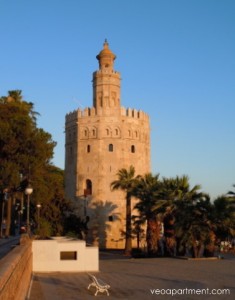This week’s post is by guest blogger and long-time Seville resident Peter Tatford Seville Concierge.
Next time you’re in Seville (or if you’re here now), make your way down to the river and take a stroll along its banks from the Puerto de Las Delicias, past the Torre del Oro (the Gold Tower), to Triana Bridge, enjoying the sunshine, the breeze, and the peace and quiet beside the water.
 But it wasn’t always like this. Allow your imagination free rein to go back to when this short stretch of the Rio Guadalquivir was one of the busiest ports in Europe. The sun is still shining and the breeze is still blowing up from the sea (if you’re lucky), but the peace and quiet has been shattered, seemingly beyond repair. Moored along the banks are dozens of the sailing ships that ply the trade with the recently discovered New World of the Americas across the nearby ocean. A shipment of gold is being unloaded, ready to be carried under guard to the storerooms of the Casa de la Moneda (the Royal Mint). Spices and other valuable trade goods sit on the docks, awaiting collection. Other ships are being loaded with provisions, or being readied for sailing. Coils of rope and canvas sheets abound. The docks are crowded with ragged sailors and stevedores, a few gaudily dressed noblemen and merchants, and even more gaudily dressed young women plying the oldest trade of them all.
But it wasn’t always like this. Allow your imagination free rein to go back to when this short stretch of the Rio Guadalquivir was one of the busiest ports in Europe. The sun is still shining and the breeze is still blowing up from the sea (if you’re lucky), but the peace and quiet has been shattered, seemingly beyond repair. Moored along the banks are dozens of the sailing ships that ply the trade with the recently discovered New World of the Americas across the nearby ocean. A shipment of gold is being unloaded, ready to be carried under guard to the storerooms of the Casa de la Moneda (the Royal Mint). Spices and other valuable trade goods sit on the docks, awaiting collection. Other ships are being loaded with provisions, or being readied for sailing. Coils of rope and canvas sheets abound. The docks are crowded with ragged sailors and stevedores, a few gaudily dressed noblemen and merchants, and even more gaudily dressed young women plying the oldest trade of them all.
This is what has made, is making, Seville the greatest, richest city in Europe, and this month marks the anniversary of the two world-changing voyages of discovery that set it all in motion.
On the evening of August 3, 1492, three small ships, the Santa Maria, the Pinta, and the Santa Clara, slipped anchor in the little harbour of Palos de la Frontera, near the mouth of the Guadalquivir, and set off in search of a western route to the spice islands of the far east. Their commander was, of course, Christopher Columbus, actually an Italian from Genoa, not a Spaniard, but his voyage was being sponsored by the Spanish monarchs, Ferdinand and Isabel, and he had a strong association with Seville, both in life, and in death, his tomb being in the city’s Cathedral. As we all know, he never found a way to China and India. Instead he discovered America, and for the next two hundred years Seville had a monopoly of the trade with the New World, and grew fat on the proceeds.
His goal of reaching the East by sailing west was achieved a generation later by another foreigner in the pay of the Spanish crown. Ferdinand Magellan was a Portuguese, making him almost guilty of treason given the competition between the two countries at that time. He set sail from Seville on his voyage to circumnavigate the world on August 10, 1519 with a fleet of five ships and 237 men, from a spot next to the Triana end of the Puente de San Telmo now marked by a rather abstract memorial. Magellan himself never returned, being killed in 1521 at Mactan in the Philippines, but just over three years after setting out the last remaining ship limped into Sanlucar de Barrameda under the command of Juan Sebastian Elcano, who has a street named after him next to Magellan’s memorial. There were just 18 men left on board, the rest having perished on the journey. Wealth doesn’t come cheap.
For more information on Seville’s seafaring past visit the naval museum in the Torre del Oro.
Apartments with a perfect view of this stretch of the river include Betis Blue 2, and two others in the same building.
Excellent piece Peter,very interesting.
Thanks Ian. We’ll pass the compliment on. Peter also has his own blog at http://sevilleconcierge.com/
Pingback: Seville | The View From Triana Bridge | veoapartment